
Originally published in The Clarinet 52/4 (September 2025).
Copies of The Clarinet are available for ICA members.
Audio Reviews:
September 2025
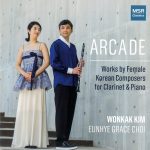
Arcade: Works by Female Korean Composers for Clarinet and Piano. Wonkak Kim, clarinet; Eunhye Grace Choi, piano. J. Seo: Arcade for clarinet and piano; N. Sohn: Weather Change for clarinet and piano; J. Na: Open Letters for clarinet and piano; J. Ahn: Blush for solo clarinet; J. Chung: Ariaria for clarinet and piano; H. Ahn: A Beautiful Polonaise for clarinet and piano; S. Uhm: Parents’ Love for clarinet and piano; E. Yu: Red Light! Green Light! for clarinet and piano. MSR Classics, MS 1779. Total Time: 52:59.
Arcade, a compelling collection of works for clarinet and piano by female Korean composers, is reminiscent of a collection of stories. Each piece expressively speaks for itself, weaving tales through a magnificent diversity of phrases, styles, and effects. Opening with the titular track Arcade by Juri Seo, the album transports us to a retro space full of buzzing sounds, neon lights, and the calamity of exciting wins and losses. Wonkak Kim and Eunhye Grace Choi perform repetitive, accented passages and ascending riffs that create dazzling imagery of a multitude of colored lights flashing around the listener.
Weather Change for clarinet and piano contrasts as a smooth, jazzy piece that is enhanced by Kim’s rich and controlled sound in all registers and dynamic ranges. The rhythmic yet smooth lines of the clarinet interplay perfectly with Choi’s groove, creating a well-balanced blend of floating sound. Segueing into the four-movement Open Letters for clarinet and piano, it is difficult not to notice how blended the musicality of Kim and Choi is. From perfectly matched articulations to impeccably balanced phrases, this piece explores a full range of characters they are able to conjure, seemingly effortlessly.
Blush is a rhapsodic clarinet solo that features quick grace notes, glistening runs, flutter tonguing, wide vibrato, and quarter tones. Kim performs this mesmerizing piece with grace and ease. His characteristically warm sound is particularly outstanding in his throat tones. He dances perfectly around the ranges of the clarinet in a bird-like character, as if his phrases are speaking to the listener in an unfamiliar language we can almost understand.
Swaying between bombastic declarations and impish mischief, Ariaria for clarinet and piano is a perfect piece for this duo. In three movements, the interplay Kim and Choi achieve perfectly aligns with the call-and-response characteristics of this piece. Their complementary musicianship is just as effective when portraying two separate characters as when creating a singular character together.
A Beautiful Polonaise for clarinet and piano is an absolutely stunning work full of melancholy colors and varying styles. Opening with the unique effect of a luscious phrase performed on flutter tongue, Kim maintains the warm color in his tone. As they move through the different characters of the piece, Choi and Kim seem to be finishing each other’s sentences. Transitioning perfectly into Parents’ Love for clarinet and piano, this piece highlights everything extraordinary the duo brings to the listener. With a passionate opening and tender, long phrases, Kim and Choi balance each chord perfectly and treat each cadence with care. Ending this spectacular album, Kim and Choi present Red Light! Green Light! for clarinet and piano as a perfect summary of the storytelling journey they have taken us on. They prance together in playful dovetailing lines and perform curious, lighthearted passages.
Arcade is an exquisite listen that highlights magnificent works by female Korean composers. Kim and Choi’s performance is virtually perfect in style, musicality, and tempo. Each phrase is carefully curated to bring out the best in each musical character. Their virtuosic technique and musicianship are enhanced by their flawless ensemble, making this album one you will want to come back to again and again!
– Sarah Manasreh-Decker
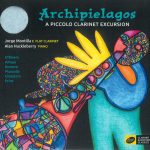
Archipielagos: A Piccolo Clarinet Excursion. Jorge Montilla, E-flat clarinet; Alan Huckleberry, piano. P. D’Rivera/adapt. J. Montilla: Invitación al Danzón; E. Amaya: Archipielagos for E-flat clarinet and piano; A. Romero/trans. J. Montilla and G. Meneses: Preludio y Quirpa; A. Piazzolla/arr. J. Montilla: La Muerte del Angel; A. Ginastera/trans. J. Montilla: Pampeana No. 1, op. 16; A. Prinz: Sonata No. 1 for E-flat clarinet and piano. Samek Music, CC0083. Total Time: 49:32.
The title Archipielagos: A Piccolo Clarinet Excursion lives up to its name as a true exploration of the E-flat clarinet and its capabilities as a solo instrument. On this album, Venezuelan clarinetist Jorge Montilla and pianist Alan Huckleberry highlight the versatility of the E-flat clarinet with a fusion of original and arranged repertoire by Latin American composers and the Viennese clarinetist and composer Alfred Prinz. Along with Prinz’s excellent Sonata No. 1, this celebration of Latin American composers exemplifies the evocative abilities of Montilla’s superb E-flat playing in a way that exudes zeal and abandon.
Paquito D’Rivera’s Invitación al Danzón (2008) provides a rousing opening track that showcases Montilla’s signature velvety sound and clear tonal focus. This fanciful homage to the Cuban dance form is lush in its conception. Montilla’s playing is agile and seamless with sensitivity of ensemble and phrase direction. The cadenza is artfully meticulous and enviable in its fluidity.
Archipielagos for E-flat clarinet and piano (2011) by Efrain Amaya is a journey through the composer’s memories of the beautiful shores and islands in Venezuela, while also considering the sociopolitical anxieties that the country faces. Written for Montilla, it is a captivating piece that immediately asks the listener to fully indulge in the auditory experience and gets to the very heart of the duality of beauty and strife. The first movement, “Las Aves,” begins with a pensive melody reminiscent of a sunrise that grows in energy and bubbles into a joyful cadenza. “Los Frailes” is a rondo in five parts that showcases Montilla’s technical prowess, especially in the impressive arpeggiated figures that embellish the underlying fanciful piano melody. This movement is effortlessly performed, belying its difficulty. The opening of “Los Testigos y Los Monjes” is based on a calypso dance that has a 12-bar phrase that grows in density and texture each time it repeats. By the third repetition, Montilla’s ornamented melody sparkles atop scalar passages performed masterfully by Huckleberry. “Los Monjes” is contemplative and introspective by comparison. The superb intonation of the clarinet in the high register is a striking feature. “Los Roques,” influenced by Afro-Venezuelan music, begins with a catchy ostinato. This declamatory rhythmic structure leads to a unique moment where the clarinet oscillates between an ostinato and material from the first section, as though there are dueling voices at play. The listener will surely be struck initially by the dazzling virtuosity of this piece, but find that its melancholic—and perhaps nostalgic—melodies stick with you long after listening.
Venezuelan pianist and composer Aldemaro Romero’s Preludio y Quirpa (1997) was transcribed by Montilla and Gabriel Meneses. Opening with a dreamlike melody in the E-flat clarinet, this languid mood is later mingled with a vigorous and playful motive. The piano has some particularly lovely moments in this piece. Huckleberry’s stylistic flair is superb, and balance between the two instruments is excellent.
La Muerte del Angel (1962-65) by Astor Piazzolla is a distinctive piece with which Piazzolla shook the conservative world of tango. “Nuevo tango = tango + tragedy + comedy + whorehouse” was an equation Piazzolla used to define his new direction. It is a driving tour de force that feels relentless in its pursuit, save a sultry interlude. The final section is performed with brilliance and flair, perfectly capturing the character of the piece.
Alberto Ginastera’s Pampeana No. 1, op. 16 (1947), was written at the end of his objective nationalism period (1937-1948) when Ginastera suffused his work with Argentine folk rhythms. Montilla gives this piece a new interpretation for the E-flat clarinet from its original version for violin. Montilla and Huckleberry do a brilliant job capturing the essence of the piece. The virtuosic fireworks are cleanly performed in a natural and almost spontaneous fashion with rhythmic unity between the clarinet and piano.
Alfred Prinz’s Sonata No. 1 for E-flat clarinet and piano (1998) consists of three short movements and harkens back to the musical idioms of Hindemith, Prokofiev, and Bartók. The first movement is a lovely missive that revolves around a rhythmic motive where the clarinet staccato is light and shows great direction. The second movement, Andante con moto, is quiet and serene in a way that allows Montilla’s subtlety of expression to shine through. The last brief movement is technically excellent and brings the work to a satisfying end.
Jorge Montilla and Alan Huckleberry present a fantastic collection of works celebrating the E-flat clarinet and its expressive capabilities in Archipielagos. Montilla’s vocal style, flexible control, and impressive intonation compliment the beauty and diversity of the repertoire. The recording quality is first-rate, and the liner notes are sufficient without being cumbersome. This album is a definite must-have for any musician or E-flat clarinet enthusiast.
– Anna Roach

Part of Me is Water. Jessica Pollack, clarinet, poetry; Galen Dean Peiskee Jr., piano. D. Bermel: SchiZm: Field of Stars; Jacob TV: Barnegat Bay; E. Williams: the waters wrecked the sky; C. Komschlies: Fear a Bhata; C. Wieland: hands; J. Montgomery: Peace; W. George: Unintentional Dances; with original poems by Jessica Pollack. Independent Release. Total Time: 63:00.
Jessica Pollack is a multifaceted artist, weaving her talents as a clarinetist, educator, psychologist, and collaborator to craft works that resonate deeply with audiences. Part of Me is Water is Pollack’s debut poetry collection, set with contemporary clarinet works. Drawing inspiration from diverse disciplines such as music, dance, poetry, improvisation, and psychology, Pollack cultivates experiences that are both intimate and profound.
Part of Me is Water is an hour-long multimedia performance of various clarinet works and recited poetry. In the words of Jessica Pollack:
Part of Me is Water grew slowly and all at once. In 2021, I encountered the clarinet work Barnegat Bay, written by composer Jacob ter Veldhuis about a storm. I was captivated by the way beauty, devastation, wonder, isolation, and humor were all enmeshed as part of a complex experience. The ability to hold conflicting emotions resonated with some of my most personal and vulnerable experiences. I thought about the poetry sketches I had written about those experiences years earlier, glimpses of which still appear in this project. Inspired, I began a year-long process of writing poetry and curating clarinet works that would form a narrative arc exploring trauma, loss, and resilience. The poems themselves tell a poignant story and yet, throughout the writing process, I had flashes of colors, images, and textures intertwined with the emotions of the text. As a musician, it felt natural to integrate music and writing as a way of guiding audiences through the experience I envisioned—one that immerses them in this journey and allows each listener to make it their own.
Pollack’s poetry and performance beautifully present works by Derek Bermel, Jacob TV, Evan Williams, Chelsea Komschlies, Cassie Wieland, Jessie Montgomery, and Whitney George.
Derek Bermel’s SchiZm: Field of Stars (1993-94) for clarinet and piano is a hauntingly beautiful, lyrical work. Pollack and Peiskee deliver a skillfully crafted performance; of particular note is Pollack’s ease across the registers. Barnegat Bay (1993) by Dutch composer Jacob TV (Jacob ter Veldhuis) is a solo clarinet work that explores flutter tonguing, long phrases with wide vibrato and large leaps. Pollack delivers a well-crafted and dramatic performance.
Three more solo clarinet works follow. Evan Williams’s the waters wrecked the sky (2012) utilizes multiphonics, growling, and a wide range of dynamics and technique, while Fear a Bhata (2013) by Chelsea Komschlies features flutter tonguing, pitch bends, and quarter tones. Cassie Wieland’s hands (2017) explores the clarinet’s extreme control of soft dynamics and lyrical qualities.
Peace (2020) by Jessie Montgomery for clarinet and piano is well known, expressing the composer coming to peace with the sadness felt during the COVID-19 pandemic. Pollack and Peiskee present a beautiful performance of this lyrical and melancholy work. Rounding out the album is Whitney George’s Unintentional Dances (2016), a set of four dances for clarinet and piano: “Refuse to Die (Tango),” “There I am a Lie (Scherzo),” “As if Standing on Fishes (Waltz),” and “The Wingbeats of your Flight (Two-Step).”
The companion booklet includes a beautiful collection of photographs to lead readers through the emotional landscape of the poetry. Pollack hopes the poetry serves as a guide through the journey of loss, pain, vulnerability, and returning from this journey. Despite heavy topics, this is intended as an optimistic work, because at the heart of any story of pain is resilience.
Pollack’s performance of the poetry and this collection of music is emotional, raw, sensitive and exciting. The music pulls the listener in and engages the ear with a cornucopia of contrasts. The collaboration with pianist Galen Dean Peiskee, Jr. is sensitive and well balanced. This album is an innovative project combining the arts of poetry, photography, and composition. Congratulations to Jessica Pollack for undertaking this creative endeavor and imaginative program.
– Julianne Kirk Doyle
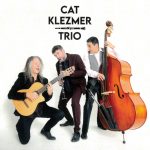
Cat Klezmer Trio. Xavi Pendón, clarinet; Xavi Torras, guitar; Joni Aldunate, double bass. Cat Klezmer Trio: Papirosn; Somni; Les Nenes Maques; Blues for Giora; El Cant dels Ocells; Sherele; Freilach Freser; Per Tu Ploro; Freilach Ora; Tumbalalaika; Sammy’s Freilach; La Santa Espina. Lalabelweb, LAB00924. Total time: 29:39.
In their 2024 debut album, the Cat Klezmer Trio presents a diversity of pieces in the klezmer style, all arranged by the ensemble to fit their unique instrumentation. Preservation and innovation are the themes of this album, so while six of the works on the album are traditional klezmer songs, the others borrow from different styles, especially the Catalan musical tradition.
The album opens with the traditional klezmer piece Papirosn, with the clarinetist Xavi Pendón playing dramatic improvisatory lines over a quickly strumming guitar before beginning the melody. From this very first piece, we are introduced to Pendón’s smooth, clear tone and mesmerizing ornamentation. This piece is followed by Somni, a sardana. Though a clear change in style from the first piece, the consistently warm clarinet tone and overall timbre and balance of the ensemble create a cohesive transition. A fun and engaging dance, the guitar occasionally deviates from the typical chordal accompaniment to play a unison melody with the clarinet. This piece also highlights Pendón’s true expertise in tonal variation, with singing and playing “growls” that vary from minimal to intense, contrasting his usual buttery smooth sound.
Shifting styles yet again, traditional Catalan children’s song Les Nenes Maques features an abundant variety of ornamentation by Pendón, which only enhances the phrasing of the melody and never distracts from the original tune. The trio’s blending of klezmer techniques with this folk song makes it even more fun, energetic, and exciting. The trio’s original composition Blues for Giora is dedicated to the “King of Klezmer,” Giora Feidman. Guitarist Xavi Torras employs more technical variety in this piece, with percussive drumming on the guitar alternating with the clarinet melody. This piece begins with a strong klezmer feel, gradually incorporates more blues elements as the piece progresses, and ends with a more heavily ornamented and jazzier version of the theme.
El Cant dels Ocells is a popular traditional Catalan Christmas song and lullaby. The trio presents a refreshing new arrangement that differs significantly from every other arrangement I have heard. The opening incorporates jazz elements, a perfect transition from the previous piece. While most arrangements are slow and reflective throughout, this one opens with a gentle clarinet melody, then becomes an energetic dance.
Following this are two traditional klezmer pieces, Sherele and Freilach Freser, a sardana, Per Tu Ploro, and three more klezmer pieces. Freilach Ora opens with a slow guitar melody before suddenly becoming fast and energetic when the clarinet melody takes over. A guitar motif creates the framework for Tumbalalaika, beginning and ending the piece as well as functioning as an ostinato over which the clarinet melody plays. Bassist Joni Aldunate shines in Sammy’s Freilach, which opens with a strong, bowed double bass sound. The album closes with a patrioticsardana, La Santa Espina.
Throughout the album, Pendón plays with a magnificent warm tone that flows impeccably across the range of the instrument. His mastery of the clarinet is evident in the effortless-sounding transitions between his typically smooth, full sound and the patches of intentional roughness sprinkled throughout, as well as his expertly smooth glissandos and shimmering vibrato. A goal of the trio is to “transcend geographical and cultural barriers,” and this album accomplishes that goal. This album is a unique introduction to traditional Catalan music presented in a new style and features both new and familiar pieces. I had so much fun listening to this album and I highly recommend it!
– Sarah Korneisel Jaegers
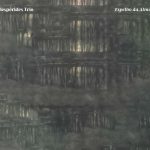
Hespérides Trio: Espelho da Alma. Rodrigo Gomes, violin; Rui Travasso, clarinet; Irene Renart, piano. E. Carrapatoso: Espelho da Alma; Três Peças Para Violino, Clarinete, e Piano; O Eterno Feminino em Peer Gynt; S. Azevedo: Pequena Suite; Música Popular. MPMP, 9MCD00099. Total Time: 51:07.
Espelho da Alma presents works for violin, clarinet, and piano by two Portuguese composers, Eurioco Carrapatoso and Sérgio Azevedo. Despite only featuring two composers, this album really showcases how diverse this instrumentation can be. Hespérides Trio was formed by Rodrigo Gomes (violin), Rui Travasso (clarinet), and Irene Renart (piano), with repertoire focusing on works by composers from the Iberian Peninsula.
The album begins with O Espelho da Alma, a set of Portuguese folk melodies that have been harmonized by the composer. The first movement, “Careto,” depicts a Portuguese carnival with dance-like rhythms, while the second movement, “Eterno,” is slower. The third movement, “Pícaro,” begins with a driving rhythm before slowing down and finally ending with the original driving rhythm (ultimately ending with a humorous musical quote). Although the entire album showcases the extreme musicianship and collaboration that the Hespérides Trio possesses, it is especially present in the fourth movement, “Materno.” The balance and blend are so exceptional that one forgets there are in fact three different instruments performing.
The album continues with another four-movement work titled Pequena Suite. Travasso shows great control over the clarinet with effortless timbral changes depending on its role in the texture. Also worth noting is the virtuosic playing of Travasso, performing large leaps smoothly and with ease. As an ensemble, the blend between instruments is superb, with melodic lines passed from player to player just as naturally as in a conversation between three friends.
Next on the album is Três Peças, a three-movement work that according to the detailed liner notes was originally for voice and piano and was inspired by a poem. The first and third movements of this work are slower and more lyrical with beautiful melodies, while the second movement is more dance-like. Following this work is a single-movement work the liner notes describe as “like a Danubian Bolero.” This piece, Música Popular, is somewhat minimalistic with a piano ostinato. Slowly the clarinet and violin sneak in with a melody and countermelody before combining into a homorhythmic melody. The intonation and balance between violin and clarinet are impeccable. This melody then alternates between being homorhythmic and more of a canon. The work concludes with a faster melody over the same piano ostinato, before ending with just the piano ostinato getting slower and softer until it fades away.
The album concludes with O Eterno Feminino em Peer Gynt, an adaptation of an incidental score that the composer wrote for a play in 2001. The first movement, “Anitra,” starts with a melody in the piano that is accompanied by violin, clarinet, and piano. The movement then abruptly changes to a faster dance-like melody with a time signature in seven before returning to the original melody. The second movement, “Solveig,” is slower, and the work concludes with “Ingrid.” This last movement has a funky groove to it and is a perfect way to end the album. Overall, this album is wonderful from start to finish and a must-have for those looking for newer works for violin, clarinet, and piano trio.
– Jeremy Wohletz
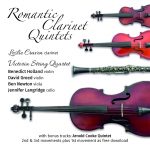 Romantic Clarinet Quintets. Leslie Craven, clarinet; Victoria String Quartet: Benedict Holland, violin; David Greed, violin; Ben Newton, viola; Jennifer Langridge, cello. J. Brahms: Clarinet Quintet in B Minor, op. 115; C.M. von Weber: Clarinet Quintet in B-flat major, op. 34; A. Cooke: Clarinet Quintet. Musical Concepts, MCS-ED-9246. Total Time: 77:00.
Romantic Clarinet Quintets. Leslie Craven, clarinet; Victoria String Quartet: Benedict Holland, violin; David Greed, violin; Ben Newton, viola; Jennifer Langridge, cello. J. Brahms: Clarinet Quintet in B Minor, op. 115; C.M. von Weber: Clarinet Quintet in B-flat major, op. 34; A. Cooke: Clarinet Quintet. Musical Concepts, MCS-ED-9246. Total Time: 77:00.
Leslie Craven and the Victoria String Quartet have released a lovely recording of the Brahms, Weber, and Cooke clarinet quintets in their album Romantic Clarinet Quintets. Leslie Craven, a fine clarinetist, is the retired principal clarinet of the Welsh National Opera while the Victoria String Quartet is an established ensemble that performs throughout the United Kingdom. Together, Craven and the quartet have added their unique take on three commonly performed clarinet quintets. The program information includes brief notes by Craven and photos of the ensemble recording the quintets. The album is unusual in that the first movement of the Cooke is not included on the CD and you must send an email to Dinmore Records requesting the movement as a free download. Dinmore responded promptly and I received the link for the movement the next day.
Starting with the Brahms quintet, the ensemble does a tremendous job of capturing the lush, emotive work with a wonderful, blended string sonority and Craven’s sensitive free-blowing tone in a very agreeable interpretation. Overall Craven’s performance is very musical and smooth. His tasteful use of vibrato and lovely tone quality are reflective of the British style of clarinet playing. He is a chanteuse with musical lines and shapes, and his tone rings and soars beautifully throughout the recording. The duo sections with the first violin in movement one are balanced and colored particularly well. The musicians expertly create the drama and nuance needed in this movement, although the tempo was faster than expected and some of the cadences could have been more drawn out for effect. Movements two and three are very solid musically, and the fourth movement is joyous and shows the tight rhythmic intensity of the ensemble.
The Weber quintet is also particularly good and performed with excitement and a great deal of energy. Craven’s “go-for-it” style in this work is very appropriate, although the forte altissimo articulations are sometimes too aggressive. However, Craven and the quartet’s use of extreme, exaggerated dynamics is very effective in this work, as in Brahms. The austere and beautiful colors of Weber’s second movement through the technical fireworks at the end of the work create a wonderful contrast. The strings and Craven play together with excellent vibrancy and color contrasts. Also, Craven uses a bit more vibrato in the Weber which helps add to the tension and release of this dramatic work.
The Arnold Cooke quintet performance is equally as inspiring as the Brahms and Weber, and the lyricism and tight ensemble playing add to its charm and verve. The ending features impressive technical passages and articulations which Craven delivers with aplomb. The recording quality is particularly good and well balanced. The works are presented with musical astuteness by Craven and the Victoria String Quartet in this delightful album of Romantic Clarinet Quintets.
– Karen Dannessa

Live! and Unbound. Nancy Williams, clarinet; Angela Mitchell, soprano; Anne Breeden, piano. E. Lutyens: Five Little Pieces op. 14, no. 1 for clarinet and piano; E. Maconchy: L’Horloge for voice, clarinet, and piano; Traditional/arr. J. MacMillan: The Blacksmith for voice and clarinet; C. von Schleicher-Krähmer: “Larghetto” from Sonatine for clarinet and piano; G. Tailleferre: Arabesque for clarinet and piano; A. Butterworth: The Night Wind, op. 38, for voice, clarinet, and piano; N. Williams: A Modern Witch for voice and piano. Carpe Clarinet. Total Time: 41:50.
Live! and Unbound, the culmination of two projects by Nancy Williams, was significantly influenced by her doctoral studies. Her exploration of the music of British women composers during this period, combined with the inspiration drawn from the live recordings of Harold Wright and the unique circumstances of the COVID-19 pandemic, led to the creation of this eclectic compilation.
Elisabeth Lutyens is remembered as a pioneer among woman composers, and an early advocate of the twelve-tone system in Britain at a time when it was derided and misunderstood. Though most comfortable in the smaller forms, she created a large output of works for the concert hall and commercial writing for the cinema. Lutyens was inspired by composers such as Debussy and Webern and was interested in twelve-tone serial techniques. These Five Little Pieces do not fit that mold; however, they do showcase her compositional style of chromaticism and dissonance to some extent. The pieces are exactly that: “little,” but little with flair and panache. Each movement is uniquely described by the clarinet and piano exchange of musical content; again, they are so short that there is not much development within each movement, but there is enough to feel like the piece works as a whole. Williams on clarinet and Breeden on piano work collectively to create a dynamic interchange for this short but enjoyable work.
Elizabeth Maconchy was of Irish-English descent, growing up in rural Ireland. She is considered one of Ireland’s greatest composers. She studied at the Royal Conservatory of Music, taught by Vaughan-Williams, but was drawn to the styles of Bartók, Berg, and Janáček. The inspiration is clear in L’Horloge for voice, clarinet, and piano. The work begins with the voice and piano, melodically angular and disjunct in texture, ostensibly clashing. The clarinet’s role is more of an interjection, adding dissonance and harmonic color to the already dissonant piece. At times, there is a sort of interplay between the clarinet and voice. It is fascinating, and while listening to the piece without any prior knowledge, it immediately made me think of Schoenberg, Berg, and Webern. This work is harmonically complex and features total chromatic expressionism, like many works by the composers mentioned earlier.
James MacMillan’s The Blacksmith begins with a clear, typical Irish folk song. A quick summary of the text reveals that the lover of this maiden has taken another and married her, leaving the maiden alone. The melodic line in the voice is strophic in form, so the verse is sung repeatedly to the same tune. The clarinet does not align with the voice’s melodic style when it enters. It sounds as if the clarinet is playing a complicated etude while the singer continues. Strange as it may seem, the clarinet line grows more elaborate as the scorned lass realizes she will never have her lover back. Williams does an amazing job with this intricate clarinet obbligato.
Caroline von Schleicher-Krähmer’s “Larghetto” from her Sonatine represents the classical style of composition. She was an accomplished clarinetist, pianist, and guitarist. It is said that she studied composition with her father and also had lessons with Franz Danzi. This piece is tuneful and straightforward, featuring classical ornamentation. Although short, it offers a lovely melody and is enjoyable to listen to. Williams implements the ornamentation expertly.
Arabesque, by Germaine Tailleferre, introduces a simple theme developed throughout this lovely work. It is ABA in form, beginning with the theme, moving into a slightly more aggressive section, and then returning to the A theme to close the piece. Short in length, it features a lovely, haunting melody that Williams effectively demonstrates through her control and musicality.
The Night Wind, op. 38, for voice, clarinet, and piano by Arthur Butterworth is a song cycle consisting of three songs with text by Emily Brontë. This piece was commissioned for the Calder Valley Festival and was first performed by the Felson Trio. This work is new to me, and I enjoy it very much. Both the voice and the clarinet collaborate to create an atmosphere that portrays the character of each poem. At times, they are light and nimble; at other times, they are bleak and dismal. You could say a bit of text painting is happening in this work, or simply that the mood is highlighted and enhanced by the clarinet. Williams successfully achieves the effect called for and adds to the piece’s character.
This album closes with an original work by Nancy Williams, A Modern Witch. Inspired by her mother-in-law, a modern-day practicing witch, the piece is lively, with twists and turns that emulate the text. I do not hear any clarinet in this work; nevertheless, it is a fun and entertaining piece performed by Mitchell and Breeden.
I enjoyed listening to Nancy Williams’s Live! and Unbound album. The diverse selections provide the listener with eclectic pieces that keep them enticed and captivated.
– Lori Ardovino
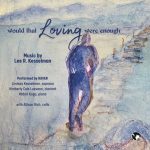
Would That Loving Were Enough. HAVEN: Lindsay Kesselman, soprano; Kimberly Cole Luevano, clarinet; Midori Koga, piano; with guest performer Allison Rich, cello. Traditional/arr. L.R. Kesselman: Sakura; L.R. Kesselman: Ashes and Dreams; Piangerò; Make Me a Willow Cabin; How I Hate This Room; Would That Loving Were Enough; G. Gershwin/arr. L.R. Kesselman: I’ll Build A Stairway to Paradise. Blue Griffin Records, BGR675. Total Time: 67:00.
HAVEN (Lindsay Kesselman, soprano; Kimberly Cole Luevano, clarinet; Midori Koga, piano) deftly brings to light a collection of world premiere recordings. Established musicians and pedagogues, HAVEN is focused on commissioning people (not pieces) by establishing relationships with their composer collaborators. This is evident through the masterful selection of works by prolific composer Lee Kesselman.
The haunting clarinet melody of Sakura opens the album. Luevano and Koga weave the timbres of the clarinet and piano into a single tone, with the clarinetist supporting and mimicking Kesselman’s gentle vocal nuances. Beautiful phrasing from the piano highlights sakura (cherry blossoms), a symbol of the fleeting nature of life, while the clarinetist dances with gentle melodies.
The multiple movements of Ashes and Dreams are built upon two alternating poetic styles of haiku and waka. To begin, the harkening dexterity and connectedness of the clarinet are imitated in the piano before Kesselman’s vocal lines draw the listener into the poetic space. Perfectly placed disjunct intervals and rapid precision note control by Luevano dominate the middle movements, while the trio displays exceptional timbral balance and intonation in the latter movements. An impatient return to the opening, complete with the clarinetist embarking on exceptionally well-placed intervallic alternations, completes the intertwining intensity of the work.
Piangerò, a reimagining of a Handel aria, freely extends the sonorities of the original while placing the composer’s hand in the creation. This work is scored for soprano and piano with cello, played by Allison Rich, enhancing the beautifully constructed ensemble dynamic. Throughout, the dynamic interplay of performers is evident, as are the delicately balanced nuances of expression.
Make Me A Willow Cabin displays the fine musical and technical control of each musician and the underlying emotions of Viola’s speech from Shakespeare’s Twelfth Night. The passionate underpinnings and dichotomy of love are evoked through deft clarinet interjections, precisely placed vocalizations, and an omnipresent restlessness in the piano. The interpretation and densely placed ensemble sensitivities take center stage.
How I Hate This Room, also for soprano, cello, and piano, tells the story of an alter-ego and slow descent into insanity by a woman sentenced to a country rest home. The ominous tones of the three musicians, a furtive interplay of tone and textures, and a passionate musicality are present in every note. The listener is captivated by the nuanced musicality, the depth of expression, and the creation of a single instrument through the stacking of timbres.
Telling the story of a relationship, the four movements of Would That Loving Were Enough are constructed with a more homogeneous texture. Lacking the quick and nimble interplay, this work showcases the balanced structures that are possible with this combination of instruments. Performed admirably, the work presents an alternate collection of sounds from the composer.
Concluding the collection, I’ll Build a Stairway to Paradise is an arrangement of the Gershwin classic. The Roaring ’20s swing and groove style is joyously performed, most notably in Luevano’s clarinet riffs. Deftly performed, this arrangement is a testament to the ensemble’s versatility.
HAVEN brings the music of Lee Kesselman to life through this powerful and evocative album. Exceptional soloists in their own right, the ensemble brings sparkle to the text and powerfully emotes the compositions. The works highlight the pinnacle of chamber ensemble collaboration by HAVEN and cellist Allison Rich. Bravo, tutti, to all involved in this delightfully produced album!
– Michelle Kiec
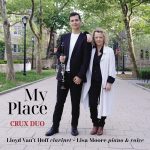
My Place. Crux Duo: Lloyd Van’t Hoff, clarinet; Lisa Moore, piano and voice. H. Steinke: Rituals; N. Russoniello/arr. L. Van’t Hoff: Dawn Searching; A. Cawrse: Since I Lost You; My Prime of Youth; E. Griswold: Danny Boy adrift in the rising tide for vocalizing pianist; E. Kats-Chernin: Russian Rag; M. Bresnick: Mayn Rue Plats (My Resting Place); L. Bernstein: Sonata for Clarinet and Piano. ABC Classic, ABCL0098. Total Time: 65:22.
My Place celebrates a blend of Australian and American music, featuring six world-premiere recordings. This album makes a significant contribution to the clarinet repertoire by presenting high-quality works that are both artistically rich and accessible to performers at a variety of levels. The interpretations by Van’t Hoff and Moore bring the music vividly to life, enriching the canon and inspiring musicians with their nuanced and expressive performances.
Rituals (2023) by Harriet Steinke is a five-movement work rooted in minimalism, full of evocative melodies and textures. Van’t Hoff and Moore handle these elements with great sensitivity and expressivity. Particularly noteworthy is the third movement, “Canons,” which is performed with sonic clarity and a refined sense of ensemble—an impressive testament to the Crux Duo’s artistry. The piece’s moderate technical demands make it approachable for clarinetists and pianists alike.
Nick Russoniello’s Dawn Searching (2014), originally for soprano saxophone and arranged for clarinet by Van’t Hoff, is a solo work inspired by birdsong. Though the piece evokes a peaceful, natural scene, this effect is only possible due to Van’t Hoff’s technical control and lyrical phrasing. He navigates the challenging passages with elegance, seamlessly integrating them into the larger musical landscape.
Anne Cawrse’s Since I Lost You and My Prime of Youth (2009), originally composed for soprano and piano, are beautifully lyrical works. The arrangements for clarinet and piano maintain the vocal expressiveness of the originals. Van’t Hoff and Moore’s interpretation honors the intent of the original songs while adding new musical depth that transcends instrumentation.
Elena Kats-Chernin’s Russian Rag (1996), arranged for the Crux Duo in 2023 by the composer herself, is stylistically reminiscent of early 20th-century Russian piano music. This lively and familiar piece, known in Australia as the theme for the ABC radio program Late Night Live, translates effectively to the clarinet and piano setting and is performed with charm and rhythmic flair.
Martin Bresnick’s Mayn Rue Plats (My Resting Place) (2020) draws on the poetry of Morris Rosenfeld, which captures the hardships of industrial laborers and their yearning for peace, love, and freedom. The clarinet line—marked by sweeping phrases and wandering, cadenza-like gestures—expresses this sense of longing with haunting poignancy. This track stands out as a highlight of the album and is a must-hear for any connoisseur of clarinet music.
The final track, Leonard Bernstein’s Sonata for Clarinet and Piano (1942) is a staple of the clarinet repertoire. Van’t Hoff and Moore bring a fresh interpretation to this classic, capturing the composer’s youthful energy and vibrant rhythm. Their performance is marked by exceptional balance and playful, well-synchronized interplay. The second movement demonstrates rhythmic assurance and allows the melodic material to soar effortlessly above the shifting meters. This recording is highly recommended for students and professionals alike seeking a compelling and insightful interpretation of this beloved standard.
– Spencer Prewitt
NEW RELEASES
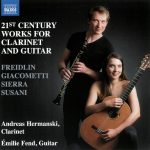
21st Century Works for Clarinet and Guitar. Andreas Hermanski, clarinet; Émilie Fend, guitar. Naxos, 8.579168.
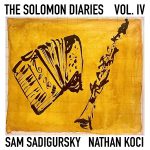
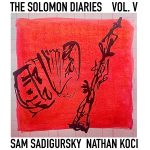
The Solomon Diaries Volumes IV and V. Sam Sadigursky, clarinet; Nathan Koci, accordion; with several guest performers. Adhyâropa Records.
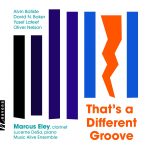
That’s a Different Groove. Marcus Eley, clarinet; Lucerne DeSa, piano; Music Alive Ensemble. Navona Records, NV6712.
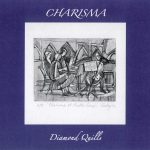
Diamond Quills. Charisma: Roslyn Dunlop, clarinet; Julia Ryder, cello; David Miller, piano. Independent release.
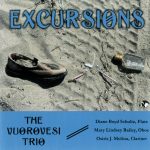
Excursions. The Vuorovesi Trio: Diane Boyd Schultz, flute; Mary Lindsey Bailey, oboe; Osiris J. Molina, clarinet. Blue Griffin Recordings, BGR681.

All in One. Calico Winds: Eileen Holt, flute; Kathleen McNerney, oboe; Kathryn Nevin, clarinet; Theresa Treuenfels, bassoon; Rachel Berry, horn. Albany Records, Troy1993.
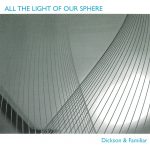
All the Light of Our Sphere. Glenn Dickson, clarinet; Bob Familiar, synthesizer. Sounds Familiar.
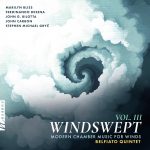
Windswept Volume III. Belfiato Quintet: Oto Reiprich, flute; Jan Souček, oboe; Jiří Javůrek, clarinet; Jan Hudeček, bassoon; Kateřina Javůrková, horn. Navona Records, NV6725.
Comments are closed.